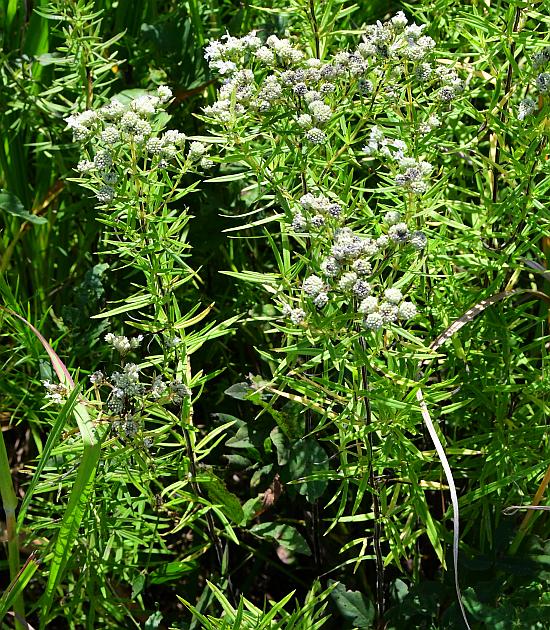Pycnanthemum virginianum (L.) B.L. Rob. & Fernald
Virginia Mountain Mint

Native
CC = 6
CW = -3
MOC = 40
© SRTurner
Pycnanthemum virginianum (L.) B.L. Rob. & FernaldVirginia Mountain Mint | |
 |
Native CC = 6 CW = -3 MOC = 40 |
© SRTurner |
|
Family - Lamiaceae Habit - Rhizomatous perennial forb. Moderately strong menthol aroma produced by bruised foliage. Stems - Ascending to erect, to 90 cm, 4-angled, branched upward, often reddish, moderately to densely and evenly pubescent on the angles with mostly short, curled hairs, the sides glabrous or nearly so.
Leaves - Opposite, simple, sessile. Blades 2-6 cm long, 5-11 mm wide, lanceolate to linear-lanceolate, angled or short-tapered at the base, the margins entire or rarely with a few teeth, the upper surface glabrous, the undersurface dotted with impressed glands and usually sparsely short-hairy along the midvein.
Inflorescences - Relatively dense, headlike clusters of numerous flowers, often appearing relatively flat-topped, only the lowermost branches observable. Bracts similar to the foliage leaves, not whitened, green, glabrous or sparsely short-hairy on the upper surface. Bractlets 2-4 mm long, lanceolate to narrowly ovate, lacking a thickened midvein, densely shorthairy toward the sharply pointed but nonspinescent tip.
Flowers - Calyces 3-5 mm long, actinomorphic or nearly so, densely pubescent, mostly above the midpoint, with short, curled hairs, the lobes all similar in size, 0.5-1.0 mm long, triangular, sharply pointed, lacking a sharply pointed extension of the midnerve. Corollas 4.0-6.5 mm long, white to pale pinkish-tinged or pale lavender, the lower lip with relatively faint purplish dots. Stamens 4, the lower pair with slightly longer filaments than the upper pair, all relatively straight and not ascending under the upper corolla lip, the anthers small, the connective very short, the pollen sacs 2, parallel, usually light to dark purple. Ovary deeply lobed, the style appearing nearly basal from a deep apical notch. Style exserted, more or less equally 2-branched at the tip.
Fruits - Dry schizocarps separating into 4 nutlets, these 1.0-2.2 mm long, glabrous.
Flowering - July - October. Habitat - Streambanks, fens, swamps, bottomland prairies, railroads; commonly on calcareous substrates. Origin - Native to the U.S. Lookalikes - Other species of Pycnanthemum, especially P. pilosum. Other info. - This species of mountain mint is scattered in Missouri, with most populations occurring in the southeastern third of the state. Missouri lies near the southern edge of the plant's natural range, which otherwise occupies most of the northeastern quadrant of the continental U.S. and also parts of Canada. It is less common in Missouri than P. pilosum, which it strongly resembles. Differentiation of the two is straightforward, as P. pilosum has stems which are densely hairy all over, whereas the stems of P. virginianum are hairy only on the angles. Another common related species, P. tenuifolium, has stems and leaves which are glabrous or nearly so. Habitat can also be a strong clue, since P. virginianum strongly prefers fen environments. Photographs taken at Shaw Nature Reserve, Franklin County, MO, 8-22-2021 (SRTurner). |